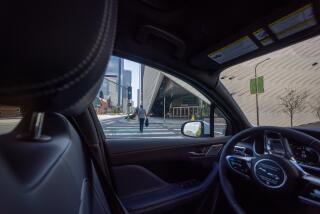Real Crash Injuries Point to Room for Improvement in Design of Cars : Safety: Low-speed test collisions, using dummies, have produced inadequate standards. A special study reveals what happens to real people and how to keep injuries to a minimum.
- Share via
BALTIMORE — A human body in a car is like an egg in a lightly padded steel box.
Imagine that box slamming into a wall at 50 m.p.h. or faster.
At the Shock-Trauma Unit here, the federal government is sponsoring the largest and most complete study to date of what happens to people in high-speed car crashes.
The preliminary findings suggest that current federal standards are insufficient to protect against devastating injuries that cost billions of dollars each year.
The standards, based on tests that use electronic dummies as stand-in passengers and drivers, are developed from the results of simulated head-on crashes into a fixed barrier at 30 m.p.h.
Since real collisions often take place at angles or from one side, however, the relevance of a head-on impact test is limited. The standards also are based on all drivers wearing seat belts--a risky assumption at best, researchers say.
“The real crashes are quite a bit different from the arbitrary ones they’re using for testing,” said Dr. John H. Siegel, who is heading the study at Shock-Trauma.
As a result, he said, some government standards are either too lax or simply irrelevant to the types of injuries that occur on the highway.
So far, the Shock-Trauma research project has gathered statistics from 55 victims of high-speed crashes who required emergency medical care for injuries from head-on or side impacts. They suffered a variety of traumatic injuries, caused mainly by parts of the car being crushed into the passenger compartment and by parts of the passenger compartment itself.
Many of the subjects had been injured in vehicles that, when new, met current federal crash test standards.
“If people were fully aware of the devastation to family life and to people’s personal dreams and hopes . . . none of us would drive around in the cars that are made today,” said Kathleen M. Read, a social worker assisting in the study.
Auto industry representatives say that their vehicles meet current federal safety rules, yet there is no arguing about the real human cost of high-speed crashes, which kill thousands of people and maim thousands of others each year.
Based on preliminary results, Shock-Trauma researchers sketched this scenario of a high-speed crash involving an unbelted driver:
In a split second, the driver’s body is assaulted by metal and glass.
His head slams against the windshield--or against the steel “A” pillar that supports the roof, cracking the skull and damaging the brain.
The chest and abdomen are smashed into the steering wheel and steering column.
In a head-on impact, the front wheel is shoved back into the passenger compartment. The “toe pan,” or floorboard, smashes into the lower extremities, causing fractures to the feet, ankles and lower legs--and perhaps trapping the driver in the wreckage.
The control panel slams forward into the knees and drives the thigh bones backward into the pelvis and hips.
In a lateral, or side crash, the car door may cave in and cause serious damage to the chest and internal organs, including the liver and spleen. One’s head may hit the “A” pillar that supports the roof or the side window frame.
The brain damage from a side impact can be even more serious than if you hit the windshield, because the side of the head houses parts of the brain responsible for speech, hearing, and coordination.
It may take 20 minutes or longer for a rescue team to cut someone out of a mangled vehicle. By then, loss of blood may have compounded brain injuries.
A survivor may face months of painful recovery, staggering medical bills and the specter of long-term disability.
Seat belts do help protect against some upper body injuries and head injuries in frontal crashes, Siegel said, but they offer little protection to the driver in a side crash, or to anyone involved in an accident in which the passenger compartment collapses.
In the study of real accidents, fewer than one in three of those involved in head-on crashes--and only about one in five of the side crash victims--were wearing seat belts.
What could be done to reduce the risk of serious injury in a high-speed crash?
Siegel suggested a number of design changes, based on the Shock-Trauma study’s preliminary findings:
* Strengthen the toe-pan and reinforce the instrument panel to cut down on injuries to the feet, legs, hips and pelvis.
* Strengthen car doors and change the placement of armrests and other features.
* Move the “A” pillar further from the occupant’s head.
* Add side-panel air bags to protect against lateral collisions.
(As of the 1990 model year, all passenger vehicles must be equipped with “passive restraints” in the front seats, either air bags or automatic seat belts. An estimated 4 million vehicles on the road had air bags as of this year, according to federal estimates.)
* Use shatterproof glass for side windows, with plastic lamination similar to the windshield, to prevent occupants from being thrown out the side.
Siegel also suggested that the laboratory crash standard speed, 30 m.p.h., is unrealistic--a view that has some auto industry support.
Siegel also advocates tougher standards to protect against head injuries, and others that would, for the first time, specifically address injuries to the pelvis, lower leg bones, ankles and feet.
Some changes are in the works already, according to federal transportation officials. The government has proposed raising the level of protection from side crashes.
A final decision on the regulations is due this year. The proposed rules would require improved door and door-latch structures and better padding on the interior of the door.
Albert Slechter, a Chrysler Corp. regulatory expert, cautioned that making cars safe to use means more than just tinkering with individual parts of the vehicle.
In a crash, “the vehicle . . . is very much a system,” whose different parts must work together to protect the passenger, he says.
To meet the 30-m.p.h. federal crash standard, for example, the car’s front end is designed to absorb some of the impact by crushing inward some 20 to 25 inches. That force otherwise would be transmitted to the passengers.
Seat belts or air bags further protect the passengers from the dangerous force of the crash, and their designs assume that crashes will take place within a certain likely range of speeds.






